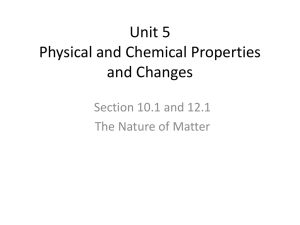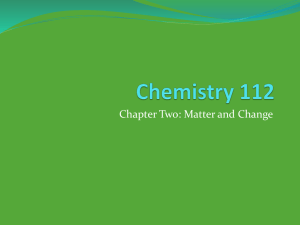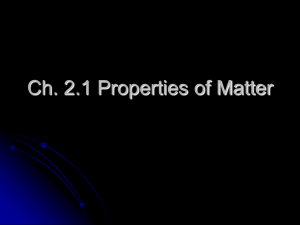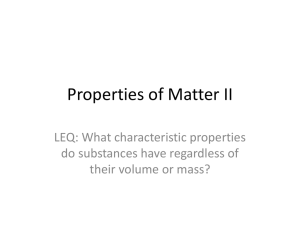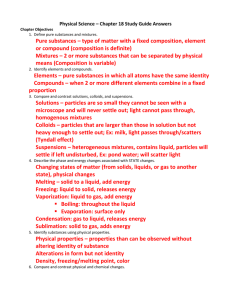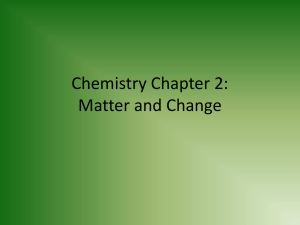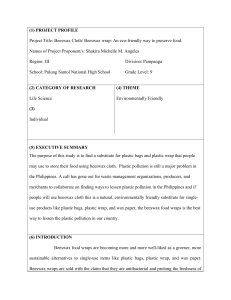MATTER Notes
advertisement
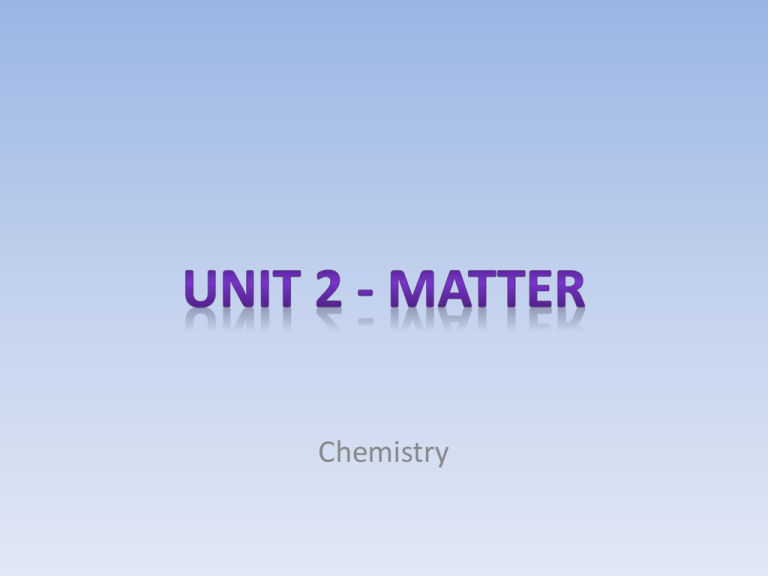
Chemistry CHEMICAL CHANGES • In a chemical change, a new substance or substances appear. • Chemical changes are not reversible by normal methods. PHYSICAL CHANGES • In a physical change, the substance does not change. • Physical changes can be reversed. Examples of Physical Changes • Cutting a piece of paper: The shape has changed, but it is still paper. • Boiling water: Water changes to steam. Steam is not a new substance; it is just a different form of water. • Dissolving salt in water: It’s hard to tell whether a new substance forms when salt dissolves in water. If we evaporate the water, we would get the salt back. That makes it a physical change, because it is reversible. All changes of state are physical changes. • Water turning to ice or to steam is always a reversible process. Ice and steam are not new substances. They are still the same water particles, just arranged a bit differently. Examples of Chemical Changes • A chemical change will involve a chemical reaction. • Cooking and burning are always chemical changes. • A chemical reaction occurs when two or more chemicals combine to produce different chemicals. • How can you identify a chemical change? - The color might change - Energy can be released - The smell might change - A gas may be produced - A precipitate may form Question 1 When a cloud forms in the sky, is it a physical or a chemical change? A) Physical change B) Chemical change Question 2 Is rusting a physical or a chemical change? A) Physical change B) Chemical change An intensive property is one that does not depend on how much material is present. An extensive property is one that does depend on the amount of substance. For example, temperature is an intensive property. If a beaker of water has a temperature, all the water has the same temperature. It doesn’t depend on how much water there is. So, mass and volume are both extensive properties. They both change if the amount of material changes. It is interesting to note that density (defined as mass/volume) is an intensive property, but it is defined in terms of two extensive properties. Examples of intensive properties include: Temperature, density, chemical potential, viscosity, electrical resistivity, specific heat capacity, melting point and boiling point, pressure Examples of extensive properties include: Energy, mass, volume, weight, length Question 1 Which of the following is an intensive property? A) Weight B) Energy C) Freezing point D) Width Question 2 Which of the following is an extensive property? A) Freezing Point B) Density C) Temperature D) Width Matter can be anything that occupies space and has mass. State of Matter Solid Liquid Gas Plasma Shape Definite Indefinite Indefinite Indefinite Volume Definite Definite Indefinite Indefinite Particle Movement Packed closely together More free to move Move independently Move independently Examples Diamonds Ice, Powder Water, Milk, Coke Helium, Hydrogen, Sun, Plasma TV Demonstration All matter possesses a certain amount of energy. However, energy is not mass, as it cannot be weighed, and it does not occupy space. Question 1 What happens to a substance at the temperature known as the melting point? A) It changes from a liquid to a gas B) It changes from a solid to a liquid C) It changes from a liquid to a solid D) It changes from a solid to a gas Question 2 "The shape of a liquid can change to fit the container it fills." Is this statement true or false? True or False Question 3 Which of the following statements applies to gases? A) They have no fixed shape or form. B) Their atoms or molecules move independently. C) Their atoms or molecules have lots of energy. D) All of the above. Question 4 Which of the following states of matter has the least energy? A) Solid B) Liquid C) Gas D) Plasma Physical properties do not change the chemical nature of matter. Physical Property Description Example States of Matter changes Energy increases/decreases to change solid to liquid to gas and vice versa Draw the States of Matter Changes Triangle Volume amount of space occupied Draw a graduated cylinder with liquid Mass amount of matter it contains Draw the a triple beam Density amount of mass per unit of its volume D = m/v Draw a marble inside a container of water Compressibility extent that the volume of a substance will change in response to pressure. Draw a hand squeezing a ball Solubility amount of it that will dissolve in a liquid under certain conditions. Draw Alkaselter dissolving in water Specific Heat Capacity amount of heat energy that is needed to raise the temperature of 1 kg of the substance by 1 K Chemical properties are only visible in a chemical reaction. A chemical property is one that will cause an irreversible change in a substance when it occurs. Examples of chemical properties include: - sulfur burns in air - iron rusts in water - hydrogen peroxide decomposes to oxygen and water - vinegar reacts with baking soda Question 1 Beeswax melts at 64° C. It is often used to make candles. Why would it be impractical to make a cooking pot from beeswax? A) Water boiled in a beeswax cooking pot would taste bad B) It would attract bees C) The beeswax would melt before the water boiled D) It would be difficult to shape the beeswax Question 2 What is a substance's melting point usually the same as? A) Its freezing point B) The point at which it evaporates C) Its boiling point D) None of the above MATTER Can it be separated by physical means? NO PURE SUBSTANCES MIXTURES Can it be decomposed by ordinary chemical means? NO ELEMENTS YES Is the composition uniform? YES COMPOUNDS YES HOMOGENEOUS MIXTURES NO HETEROGENEOUS MIXTURES MATTER Can it be separated by physical means? NO PURE SUBSTANCES MIXTURES Can it be decomposed by ordinary chemical means? NO ELEMENTS YES Is the composition uniform? YES COMPOUNDS YES HOMOGENEOUS MIXTURES NO HETEROGENEOUS MIXTURES
